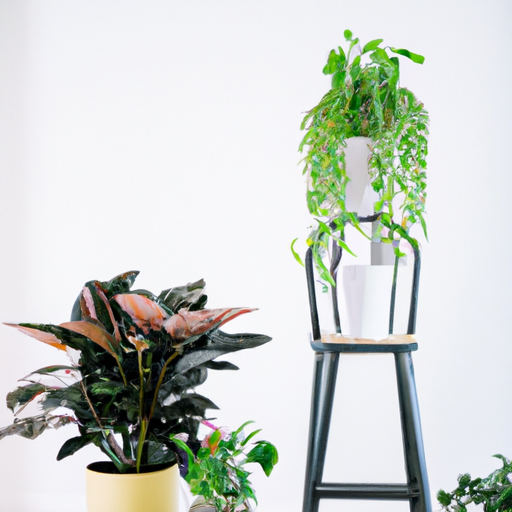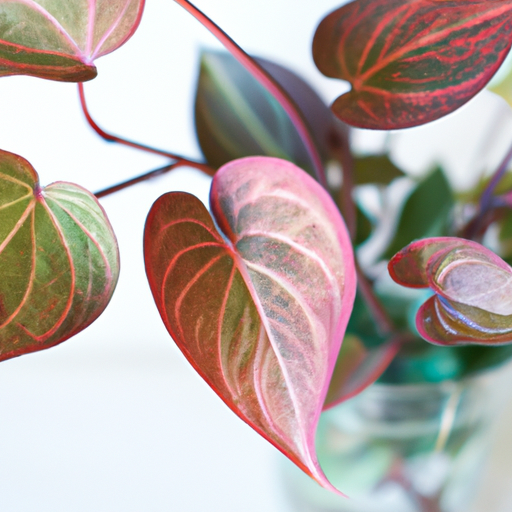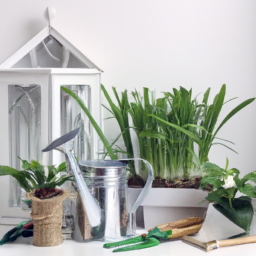
Maximizing Space: Creative Ideas for Indoor Gardening in Small Living Spaces
Introduction
Living in a small space doesn’t mean you have to give up your love for gardening. With a little creativity and some smart planning, you can create an indoor garden that thrives in even the tiniest of living spaces. In this guide, we will explore various tips and techniques to help you maximize space and create a lush indoor garden that brings life and beauty to your small living space.
Choosing the Right Plants
When it comes to indoor gardening in small living spaces, choosing the right plants is crucial. Opt for plants that are compact in size and can thrive in low light conditions. Some great options include:
Succulents: These water-storing plants come in a variety of shapes and sizes, making them perfect for small spaces. They require minimal care and can tolerate low light conditions.
Herbs: Fresh herbs not only add flavor to your meals but also make great indoor plants. Choose compact varieties like basil, parsley, and thyme, which can be grown in small pots or hanging baskets.
Air Plants: These unique plants don’t require soil and can be attached to various surfaces like driftwood or hanging terrariums. They are perfect for adding a touch of greenery to small spaces.
Vertical Gardening
One of the most effective ways to maximize space in indoor gardening is through vertical gardening. By utilizing vertical wall space, you can create a stunning green wall that not only saves space but also adds visual interest to your living area. Here are some ideas for vertical gardening:
Wall-mounted Planters: Install wall-mounted planters to grow your favorite plants vertically. You can choose from a variety of designs and sizes to fit your space and style.
Hanging Baskets: Hang baskets from the ceiling or wall hooks to create a hanging garden. This is a great way to grow trailing plants like pothos or ivy.
Vertical Garden Systems: Consider investing in a vertical garden system that allows you to stack multiple planters vertically. These systems are perfect for growing herbs, salad greens, and small flowering plants.
Utilizing Small Spaces
In small living spaces, every inch counts. Here are some tips to help you make the most of your limited space:
Window Sills: Transform your window sills into mini gardens by placing small pots or trays filled with plants. This not only adds greenery but also makes use of the natural light.
Shelves: Install floating shelves or wall-mounted shelves to create additional space for your plants. Arrange them in a visually appealing way to create a living wall effect.
Unused Corners: Make use of those awkward corners by placing tall plants or vertical garden systems. This not only adds greenery but also fills up empty spaces.
Caring for Your Indoor Garden
Proper care is essential for the success of your indoor garden. Here are some tips to keep your plants healthy and thriving:
Lighting: Most indoor plants require bright, indirect light. Place your plants near windows or invest in grow lights to provide them with adequate light.
Watering: Avoid overwatering your plants, as this can lead to root rot. Check the moisture level of the soil before watering and adjust accordingly. Succulents and air plants require less water compared to other plants.
Fertilizing: Indoor plants benefit from regular fertilization. Use a balanced, water-soluble fertilizer and follow the instructions on the packaging for the correct dosage.
Pruning: Regularly prune your plants to promote healthy growth and prevent them from becoming too leggy. Remove any yellowing or dead leaves to maintain the overall appearance of your indoor garden.
Conclusion
Indoor gardening in small living spaces can be a rewarding and fulfilling experience. By maximizing space, choosing the right plants, and providing proper care, you can create a beautiful indoor garden that brings nature indoors. Get creative, think vertically, and make the most of every inch of your space to create a lush oasis in your small living area.
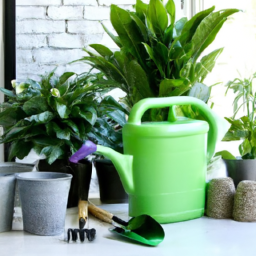
Choosing the Right Plants: Indoor Gardening Tips for Small Apartments and Condos
Indoor gardening is a great way to bring nature into your small living space, whether you live in an apartment or a condo. With the right plants and a little bit of care, you can create a green oasis that not only adds beauty to your home but also improves air quality. However, when it comes to indoor gardening in small spaces, choosing the right plants is crucial. Here are some tips to help you select the perfect plants for your indoor garden:
1. Consider the Lighting Conditions
The first step in choosing the right plants for your small living space is to assess the lighting conditions. Most indoor plants require bright, indirect light to thrive. If your apartment or condo receives a lot of natural light, you have a wide range of options. However, if your living space lacks natural light, you can still grow plants that tolerate low-light conditions, such as snake plants or pothos.
It’s important to note that different plants have different light requirements, so it’s essential to match the plant’s needs with the available light in your home. You can also supplement natural light with artificial grow lights to ensure your plants get the necessary light they need to flourish.
Another factor to consider is the direction your windows face. South-facing windows receive the most sunlight, while north-facing windows receive the least. East-facing windows provide gentle morning light, while west-facing windows offer brighter afternoon light. Understanding your lighting conditions will help you choose plants that are well-suited for your space.
2. Assess the Space Availability
When it comes to indoor gardening in small living spaces, it’s crucial to assess the space availability before selecting plants. Measure the available floor space, windowsills, and any other areas where you plan to place your plants. This will help you determine the size and quantity of plants you can accommodate.
If you have limited floor space, consider vertical gardening options. Hanging planters, wall-mounted shelves, or even a simple bookshelf can be utilized to create a vertical garden. This not only maximizes space but also adds a unique and eye-catching element to your indoor garden.
Additionally, consider the height and spread of the plants you choose. Some plants, like trailing vines, are perfect for hanging baskets, while others, like tall palms, can add vertical interest to a room. By selecting plants that fit your available space, you can create a well-balanced and visually appealing indoor garden.
3. Determine the Maintenance Level
Before selecting plants for your indoor garden, it’s essential to consider the level of maintenance you are willing to commit to. Some plants require more care and attention than others. If you have a busy lifestyle or lack a green thumb, opt for low-maintenance plants that are forgiving and can withstand occasional neglect.
Succulents and cacti are popular choices for low-maintenance indoor gardens. They require minimal watering and can tolerate dry conditions. Spider plants and peace lilies are also relatively easy to care for and can thrive in a variety of environments.
On the other hand, if you enjoy the process of gardening and have the time to dedicate to plant care, you can choose more demanding plants like orchids or ferns. These plants may require specific humidity levels, regular watering, and occasional pruning.
Remember that the key to successful indoor gardening is to choose plants that align with your lifestyle and the amount of time you can dedicate to their care.
In conclusion, when it comes to indoor gardening in small living spaces, choosing the right plants is essential. Consider the lighting conditions, assess the space availability, and determine the maintenance level you can commit to. By following these tips, you can create a thriving indoor garden that brings beauty and nature into your apartment or condo.
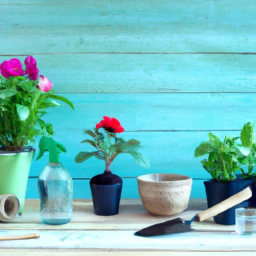
Vertical Gardening: Utilizing Wall Space for Indoor Gardens in Compact Living Areas
Indoor gardening is a fantastic way to bring some greenery into your small living space. However, with limited floor space, it can be challenging to find room for traditional potted plants. That’s where vertical gardening comes in. By utilizing wall space, you can create a stunning indoor garden that not only adds beauty to your home but also maximizes your living area. In this article, we will guide you through the process of setting up a vertical garden in your compact living space.
Choosing the Right Wall for Your Vertical Garden
The first step in creating a vertical garden is to choose the right wall for your plants. Ideally, you want a wall that receives sufficient sunlight throughout the day. South-facing walls are usually the best choice as they receive the most sunlight. However, east or west-facing walls can also work well if they receive at least six hours of direct sunlight daily. Avoid north-facing walls as they tend to be darker and receive less sunlight.
Once you’ve identified the suitable wall, it’s time to prepare it for your vertical garden. Make sure the wall is clean and free from any dirt, dust, or debris. You may need to wipe it down or give it a gentle wash if necessary. Additionally, check for any cracks or holes that need to be repaired before proceeding.
Now that your wall is ready, it’s time to move on to the next step.
Choosing the Right Plants for Your Vertical Garden
When it comes to selecting plants for your vertical garden, there are a few things to consider. First and foremost, choose plants that thrive indoors and can tolerate the conditions of your living space. Some popular options for vertical gardens in small living areas include pothos, spider plants, philodendrons, and ferns. These plants are known for their ability to grow in low-light conditions and are relatively low-maintenance.
Another factor to consider is the size of the plants. Since you’re working with limited space, opt for plants that don’t grow too large or spread out too much. Compact varieties or plants that can be easily trained to grow vertically, such as trailing vines, are ideal choices for vertical gardens in small living spaces.
Lastly, consider the aesthetic appeal of the plants. Choose a variety of plants with different colors, textures, and shapes to create an eye-catching display on your vertical garden wall.
Setting Up Your Vertical Garden
Now that you have chosen the wall and the plants, it’s time to set up your vertical garden. There are several methods you can use to create a vertical garden, including hanging planters, wall-mounted shelves, and vertical planters specifically designed for this purpose. Choose the method that best suits your space and personal preferences.
If you opt for hanging planters, make sure they are securely fastened to the wall to prevent accidents. Wall-mounted shelves can be a great option for displaying multiple plants while adding a decorative touch to your living space. Vertical planters, on the other hand, are specifically designed to maximize vertical space and often come with built-in irrigation systems to make plant care easier.
Once you have installed your chosen method, carefully place your plants in their designated spots. Take into consideration the specific light and water requirements of each plant, and arrange them accordingly. Remember to leave enough space between plants to allow for growth and proper airflow.
After setting up your vertical garden, make sure to regularly monitor the plants’ health and provide them with the necessary care, including watering, fertilizing, and occasional pruning. With proper maintenance, your indoor vertical garden will thrive and bring life to your small living space.
In conclusion, vertical gardening is an excellent solution for indoor gardening in small living spaces. By utilizing wall space, you can create a stunning and functional indoor garden that maximizes your living area. Follow the steps outlined in this guide to choose the right wall, select suitable plants, and set up your vertical garden. With a little care and attention, your indoor garden will flourish, adding beauty and freshness to your compact living space.
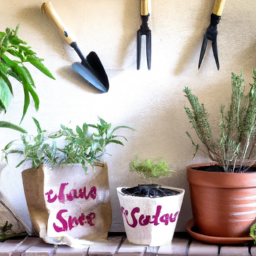
Container Gardening: Tips and Tricks for Growing Plants in Limited Space
Indoor gardening is a wonderful way to bring the beauty of nature into your small living space. Whether you have a tiny apartment, a cramped office, or simply want to add some greenery to your home, container gardening is the perfect solution. With a little creativity and these tips and tricks, you can create a thriving indoor garden that will brighten up any space.
Choosing the Right Containers
The first step in successful container gardening is selecting the right containers for your plants. When space is limited, it’s important to choose containers that are both functional and aesthetically pleasing. Here are a few tips to keep in mind:
1. Size Matters: Consider the size of your plants when choosing containers. Ensure they have enough room for their roots to grow and thrive.
2. Drainage is Key: Make sure your containers have drainage holes to prevent waterlogging. If your chosen container doesn’t have holes, you can create them yourself using a drill or hammer and nails.
3. Material Selection: Containers come in various materials such as plastic, ceramic, terracotta, or even repurposed items like old buckets or mason jars. Consider the weight, durability, and style that best suits your space.
Choosing the Right Plants
Not all plants are suitable for indoor gardening, especially in small spaces. Here are some factors to consider when selecting plants for your indoor garden:
1. Light Requirements: Assess the amount of natural light your space receives. Some plants thrive in direct sunlight, while others prefer shade or indirect light. Choose plants that match your available light conditions.
2. Space Considerations: Opt for plants that don’t outgrow their containers too quickly. Look for compact varieties or plants that can be pruned easily to maintain their size.
3. Maintenance Level: Consider your gardening skills and the time you can dedicate to plant care. Some plants require more attention and care than others. Choose plants that fit your lifestyle and schedule.
Creative Arrangement and Design
Now that you have your containers and plants ready, it’s time to get creative with your indoor garden arrangement. Here are some ideas to make the most of your limited space:
1. Vertical Gardening: Utilize vertical space by installing wall-mounted shelves or hanging planters. This allows you to grow more plants without sacrificing valuable floor space.
2. Grouping Plants: Create visually appealing arrangements by grouping plants with similar care requirements. This not only saves space but also makes it easier to care for them.
3. Utilize Windowsills: Windowsills are perfect for displaying small potted plants or herbs. Take advantage of this space by placing plants that thrive in bright, indirect light.
By following these tips and tricks, you can successfully create an indoor garden in even the smallest of living spaces. Remember to choose the right containers, select suitable plants, and get creative with your arrangement. Indoor gardening not only adds beauty to your home but also provides a calming and therapeutic environment. Happy gardening!
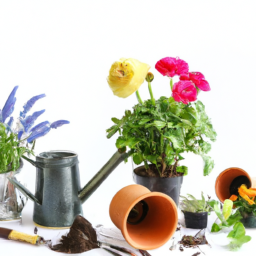
Lighting and Watering: Essential Tips for Successful Indoor Gardening in Small Living Spaces
Indoor gardening is a great way to bring nature into your small living space. Whether you live in a tiny apartment or have limited outdoor space, you can still enjoy the benefits of gardening by creating an indoor oasis. However, to ensure the success of your indoor garden, proper lighting and watering are essential. In this guide, we will provide you with expert tips on how to optimize lighting and watering for your indoor plants.
1. Lighting
When it comes to indoor gardening, lighting plays a crucial role in the growth and health of your plants. Since natural sunlight may be limited in small living spaces, it is important to provide adequate artificial lighting to compensate for this deficiency.
Firstly, choose the right type of lighting for your plants. LED grow lights are highly recommended for indoor gardening due to their energy efficiency and ability to provide the necessary light spectrum for plant growth. Position the lights at an appropriate distance from your plants to ensure they receive adequate light without burning them.
Secondly, consider the duration of lighting. Most indoor plants require around 12-16 hours of light per day for optimal growth. Set up a timer to ensure consistent lighting and to mimic natural daylight cycles. This will help your plants establish a healthy growth pattern.
Lastly, monitor the intensity of the light. Different plants have varying light requirements, so it is crucial to understand the specific needs of your indoor garden. Some plants thrive in bright, direct light, while others prefer indirect or filtered light. Adjust the intensity of the lighting accordingly to avoid scorching or stunting the growth of your plants.
2. Watering
Proper watering is another vital aspect of successful indoor gardening. Overwatering or underwatering can lead to root rot, fungal diseases, and even the death of your plants. Here are some tips to help you master the art of watering:
First and foremost, understand the watering needs of your plants. Different species have different water requirements, so it is important to research and group your plants accordingly. This will prevent over or under-watering certain plants, ensuring their optimal growth.
Check the moisture level of the soil regularly. Stick your finger about an inch into the soil and if it feels dry, it’s time to water your plants. If it feels moist, hold off on watering to avoid waterlogging the roots. Investing in a moisture meter can also help you accurately determine the moisture content of the soil.
When watering, make sure to use room temperature water. Cold water shocks the roots and can hinder their ability to absorb nutrients. Allow the water to sit for a while to reach room temperature before using it on your plants.
Furthermore, ensure proper drainage for your pots. Excess water should be able to drain out easily to prevent waterlogging. Use pots with drainage holes or add a layer of stones at the bottom of the pot to facilitate drainage.
Lastly, avoid overwatering your plants. It is better to underwater than to overwater, as most indoor plants are more tolerant of dry conditions than excessive moisture. Remember, it is easier to revive a slightly dehydrated plant than to save one suffering from root rot.
3. Humidity and Additional Tips
Apart from lighting and watering, maintaining the right humidity level in your small living space can greatly benefit your indoor garden. Most indoor plants thrive in a humidity range of 40-60%. Here are some tips to increase humidity:
– Group your plants together. As plants transpire, they release moisture into the air, creating a microclimate of higher humidity around them.
– Place a tray of water near your plants. As the water evaporates, it increases the humidity level in the surrounding area.
– Mist your plants regularly. Use a spray bottle to mist the leaves of your plants, especially during dry seasons or when your indoor space lacks humidity.
Additionally, ensure proper air circulation in your small living space. Stagnant air can lead to the growth of mold and mildew, which can harm your plants. Use fans or open windows to promote air movement and prevent the buildup of excess moisture.
Lastly, remember to regularly inspect your plants for signs of pests or diseases. Indoor plants are not immune to infestations, so keep an eye out for common pests like aphids, spider mites, and mealybugs. Promptly address any issues to prevent the spread and damage to your precious indoor garden.
By following these expert tips on lighting, watering, humidity, and additional care, you can create a thriving indoor garden in even the smallest of living spaces. Enjoy the beauty and benefits of nature right at home!
Indoor Gardening Tips for Small Living Spaces
Frequently Asked Questions (FAQ)
1. What are the benefits of indoor gardening in small living spaces?
Indoor gardening in small living spaces allows you to enjoy the benefits of gardening even without a large outdoor area. It improves air quality, reduces stress, enhances aesthetics, and provides fresh herbs or produce.
2. What are some suitable plants for indoor gardening in small spaces?
There are several plants that thrive in small living spaces. Some popular choices include herbs like basil, mint, and parsley, as well as small flowering plants like African violets and succulents.
3. How much sunlight do indoor plants need?
The amount of sunlight required varies depending on the plant species. However, most indoor plants prefer bright, indirect light. It’s essential to place them near windows or provide artificial grow lights if natural light is limited.
4. How often should I water my indoor plants?
The watering frequency depends on various factors such as plant type, pot size, humidity, and temperature. Generally, it’s recommended to water indoor plants when the top inch of soil feels dry. Avoid overwatering, as it can lead to root rot.
5. Can I use regular potting soil for indoor gardening?
Regular potting soil may not be suitable for indoor gardening as it can retain too much moisture. It’s better to use a well-draining potting mix specifically formulated for indoor plants. These mixes often contain peat moss, perlite, or vermiculite.
6. How can I deal with limited space for indoor gardening?
If you have limited space, consider vertical gardening using hanging planters or wall-mounted shelves. You can also utilize windowsills, balconies, or invest in compact plant stands or tiered planters to maximize space.
7. Are there any low-maintenance indoor plants for beginners?
Yes, there are several low-maintenance indoor plants suitable for beginners. Some examples include snake plants, pothos, ZZ plants, and spider plants. These plants are known for their ability to tolerate various light and watering conditions.
8. How do I prevent pests in my indoor garden?
To prevent pests, ensure good air circulation around your plants and avoid overwatering. Regularly inspect your plants for signs of pests such as spider mites or aphids. If an infestation occurs, you can use organic pest control methods or insecticidal soaps.
9. Can I grow vegetables indoors in small living spaces?
Absolutely! Many vegetables can be grown indoors, even in small living spaces. Some suitable choices include cherry tomatoes, lettuce, peppers, and herbs like chives or thyme. Just ensure they receive enough light and proper care.
10. How can I provide humidity for indoor plants?
Indoor environments can be dry, especially during winter months. To increase humidity, you can use a humidifier, place a tray of water near your plants, or mist them regularly with water. Grouping plants together can also create a microclimate with higher humidity.
Emily Bloomfield is an interior designer and horticulturist specializing in incorporating indoor plants into interior spaces. With a background in both design and plant science, Emily offers a unique perspective on creating harmonious living environments through the synergy of greenery and aesthetics. Her creative ideas and innovative solutions make her a sought-after authority in the field.

